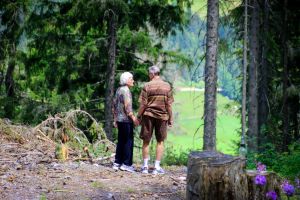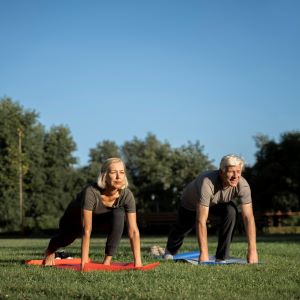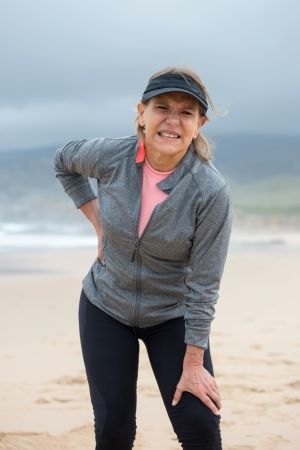Aging is a journey that unfolds differently for everyone, but we’ve all got some similar themes running through our stories. As we grow older, our muscles start to lose their might. This isn’t just about losing strength—it’s about how it feels harder to do once-easy tasks, like climbing stairs or carrying groceries. But don’t worry, this is a regular part of aging, happening to everyone as time goes on.
Bones, too, have their tale to tell. They become less dense and more prone to breaks or fractures. It’s why osteoporosis is more common in older folks. Keeping our bones in good shape is crucial to enjoying those long walks in the park without worries.
Metabolism slows down as the years pass. Many of us notice that we can’t quite eat as much as we used to without packing on some extra pounds. Our body’s engine just doesn’t burn fuel as fast as it used to, which explains those sudden bulges around the waistline.
While we’re talking about the facts, let’s bust some age-related myths wide open. Aging doesn’t have to mean becoming frail or mentally sluggish. With the right lifestyle choices, yes, wrinkles are inevitable, but the rest is more in your hands than you might think.
Genetics definitely play a part in how we age, but the environment around us—our diet, our activity level, our stress management—can play big roles too. It’s not all about what we’ve inherited; it’s also about the choices we make every day.
So there you have it: aging is not just numbers accumulating; it’s a mix of changes in our muscles, bones, metabolism, and sometimes even how we view the world. Understanding these shifts is the first step in making those golden years truly shine.
Exercise and Aging: Can Activity Turn Back the Clock?
When it comes to aging gracefully, staying active is like your golden ticket. Exercise isn’t just something that keeps you fit physically; it plays a big part in how you feel mentally too. Research keeps pointing out that regular physical activity can actually help slow down those pesky age-related changes.
Imagine exercise as hitting the pause button on some of aging’s less welcome effects. Studies have shown that movement can lead to improved muscle mass and strength and even enhance bone health. Staying active can also rev up your metabolism, counteracting some of that age-related slowdown.
But what if you haven’t been a gym buddy all your life? No worries! The great news is that it’s never too late to start. Many seniors who’ve taken up exercising later in life report significant benefits. These aren’t just improvements in strength and balance but also in mood and cognitive abilities. If you are looking for an easy way to dive into exercise, check out my post on Basic stretching exercises, where you can easily start to stretch your body and get the ‘engine’ start moving.
Exercise helps clear the mental fog. There’s something about a bit of sweat and a raised heart rate that sharpens the mind. For those in their senior years, physical activity has been shown to delay cognitive decline, keeping the mind agile and ready for the next crossword puzzle.
Keep in mind that exercise isn’t just about the physical gains. It’s also a fantastic mood booster. Regular activity often leads to better emotional well-being, combating feelings of depression and anxiety common in older adults. Who doesn’t feel better after a brisk walk in the fresh air or a gentle yoga class?
So, while exercise might not literally turn back the clock, it sure can make those minutes tick a little more kindly, helping you embrace aging with energy and gusto.
Designing an Age-Appropriate Exercise Regimen for Seniors
Creating a workout plan tailored for seniors doesn’t have to be complicated or overwhelming. It’s all about finding activities you enjoy and that your body can handle. For starters, think about adding some strength training to your routine. This doesn’t mean hitting heavy weights like a bodybuilder. Simple exercises like lifting light dumbbells or using resistance bands can do wonders for building muscle and improving bone health.
Balance exercises are another gem for seniors. These can be as simple as standing on one leg or practicing Tai Chi. The aim here is to prevent falls and enable you to move confidently, whether it’s navigating stairs or uneven pavements.
Don’t forget about flexibility activities. Stretching keeps your joints moving smoothly and can help prevent stiffness and pain. Yoga or gentle stretching sessions a couple of times a week can help with that. And hey, if you’ve got a peaceful outdoor space, why not stretch in nature’s gym? As a starting point, you can follow the yoga poses I present on my other post, which are very easy to follow from home.
Safety is a big deal when starting or ramping up an exercise program. Start slow and listen to your body. If something doesn’t feel right, pause and reassess. Maybe swap it out for something more comfortable.
There are also inspiring success stories out there to motivate you. Many seniors have embraced regular physical activity, reporting not just better physical health but a reinvigorated sense of life. They often say they feel younger and more vibrant than they have in years.
Wondering how to start this workout adventure? Chatting with a healthcare provider or a fitness professional can point you in the right direction, offering tips tailored to your current health conditions and fitness levels.
So grab those walking shoes, stretch out those arms, and step into an active lifestyle that supports your journey to healthy aging.
Beyond Exercise: Holistic Approaches to Mitigate Aging Effects
Physical activity is a strong player in maintaining youthfulness, but other factors also weave into the aging tapestry. Nutrition, for instance, is fundamental. A well-balanced diet rich in vegetables, lean proteins, and whole grains fuels the body properly, supporting energy levels and overall health. Consider it as feeding your body the good stuff to keep it running smoothly. On my post Is it better to eat before or after exercise, you can find plenty of ideas on healthy food and snacks to follow, so check it out.
Hydration carries its weight in gold. As we age, our sense of thirst might dwindle, but staying hydrated is crucial. It helps maintain skin elasticity, aids digestion, and supports cellular functions. So, always keep that water bottle handy!
Let’s not sleep on sleep. Quality rest is invaluable. It’s when the body repairs itself, which includes muscle recovery and memory consolidation. Making a bedtime routine that ensures deep, restorative sleep is a stepping stone to combating the signs of aging.
Social interactions and keeping the mind engaged can’t be overlooked either. Enjoying time with friends or family and partaking in activities like puzzles, reading, or even learning something new, can keep the brain active, warding off that dreaded cognitive decline.
There’s also a buzz around emerging therapies aimed at slowing down the aging process. While some are still exploratory, many of these therapies can work well alongside a healthy lifestyle to promote longevity. It’s wise to stay informed about these options and consider them as part of a broader approach to aging.
In the end, nurturing a lifestyle that includes regular physical activity, good nutrition, sufficient water intake, restful sleep, and social engagement paints a fuller, more vibrant picture of aging. It’s all these elements together that guide you through those golden years with health and vitality.
